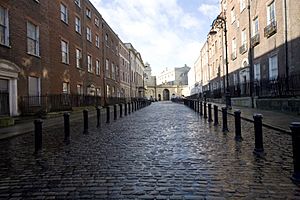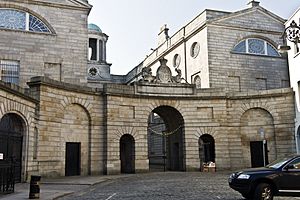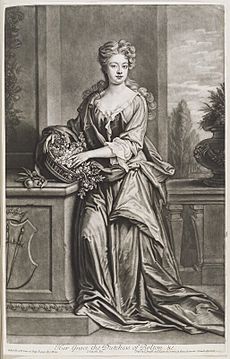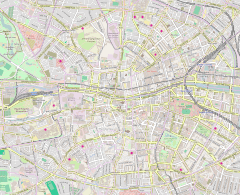Henrietta Street, Dublin facts for kids
| Sráid Henrietta | |

Looking northwest towards Gandon's Kings Inns building at the top of Henrietta Street
|
|
| Namesake | Henrietta, Duchess of Grafton (1690–1726); or Henrietta Paulet, Duchess of Bolton (1697–1730) |
|---|---|
| Length | 160 m (520 ft) |
| Width | 17 metres (56 ft) |
| Location | Dublin, Ireland |
| Postal code | D01 |
| Coordinates | 53°21′09″N 6°16′12″W / 53.35250°N 6.27000°W |
| northwest end | Archway leading to King's Inns |
| southeast end | Bolton Street |
| Other | |
| Known for | Georgian Dublin, tenements, 14 Henrietta Street |

Henrietta Street (Irish: Sráid Henrietta) is a famous street in Dublin, Ireland. It's located north of Bolton Street. This street was first planned and built by Luke Gardiner in the 1720s.
Henrietta Street is much wider than most streets from the 18th century. It features many large, red-brick buildings. These buildings are designed in the beautiful Georgian style.
Contents
What's in a Name?

The street is likely named after Henrietta Somerset (1690–1726). She was the wife of Charles FitzRoy, the second Duke of Grafton.
However, some people think it might be named after Henrietta Crofts (1697–1730). She was the third wife of Charles Paulet, the second Duke of Bolton. Bolton Street, which is nearby, is named after him.
A Look Back: Henrietta Street's History
Henrietta Street is Dublin's very first Georgian street. It set the style for many other grand streets in Dublin later on.
Building the Street
Building work on the street began in the mid-1720s. This was on land that the Gardiner family bought in 1721. Construction continued for many years, even into the 1750s. Luke Gardiner, who developed the street, had his own large house built here around 1730. It was designed by a famous architect, Richard Cassels.
"Primate's Hill"
People often called Henrietta Street "Primate's Hill." This was because one of the houses belonged to the Archbishop of Armagh. However, this house and two others were later taken down. They made way for the Law Library of King's Inns.
From Grand Homes to Crowded Tenements
During the 19th and 20th centuries, the grand houses on Henrietta Street changed a lot. They became known as tenements. This means that large houses, once home to rich families, were divided into many small, crowded apartments. Poor families lived in these tiny spaces.
By 1911, a shocking 835 people lived in poverty in just 15 houses on the street. Some houses were still used as tenements until the 1970s. In recent years, there have been big efforts to restore and fix up the street.
Henrietta Street on Screen
Because of its old, historic look, Henrietta Street has been used in movies and TV shows. Some productions filmed here include Albert Nobbs, Inspector George Gently, and Foyle's War.
The Street Today
Henrietta Street is a cul-de-sac, meaning it's a dead-end street. The Law Library of King's Inns stands at its far end. As of 2017, there are 13 houses on the street. One special house, 14 Henrietta Street, opened as a museum in late 2018. This museum tells the story of the building and the many people who lived there over the years.
Who Lived Here First?
When it was first built, Henrietta Street was popular with wealthy families. These included landowners and successful merchants. Many important noble families, called hereditary peers, owned homes here in the mid-1700s. The houses were designed with gardens at the back and separate buildings called mews.
Notable Early Residents
- Thomas Carter: A well-known politician.
- Luke Gardiner: The developer of the street, who had his own home here.
- Richard, 3rd Viscount Molesworth: An important military leader. His house, No. 14, is now the museum.
- William Stewart, 3rd Viscount Mountjoy: Another important noble.
Images for kids





